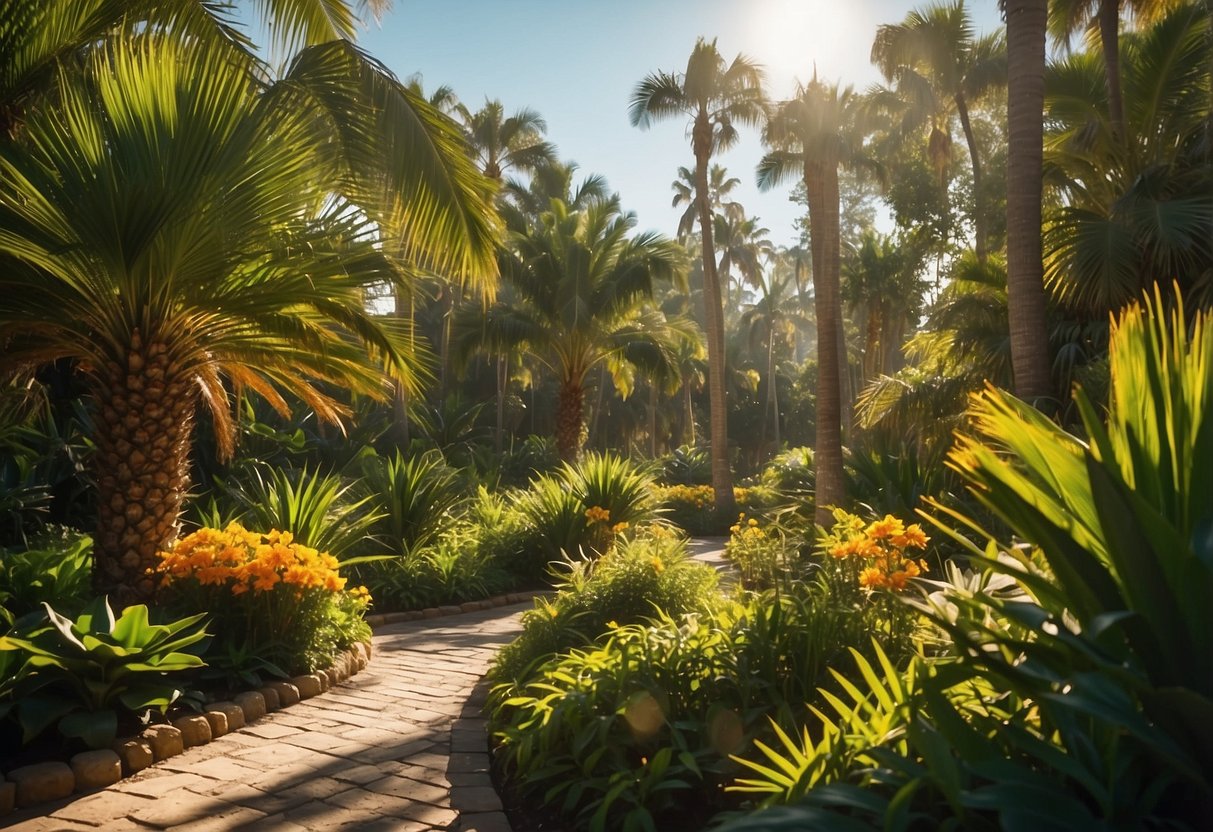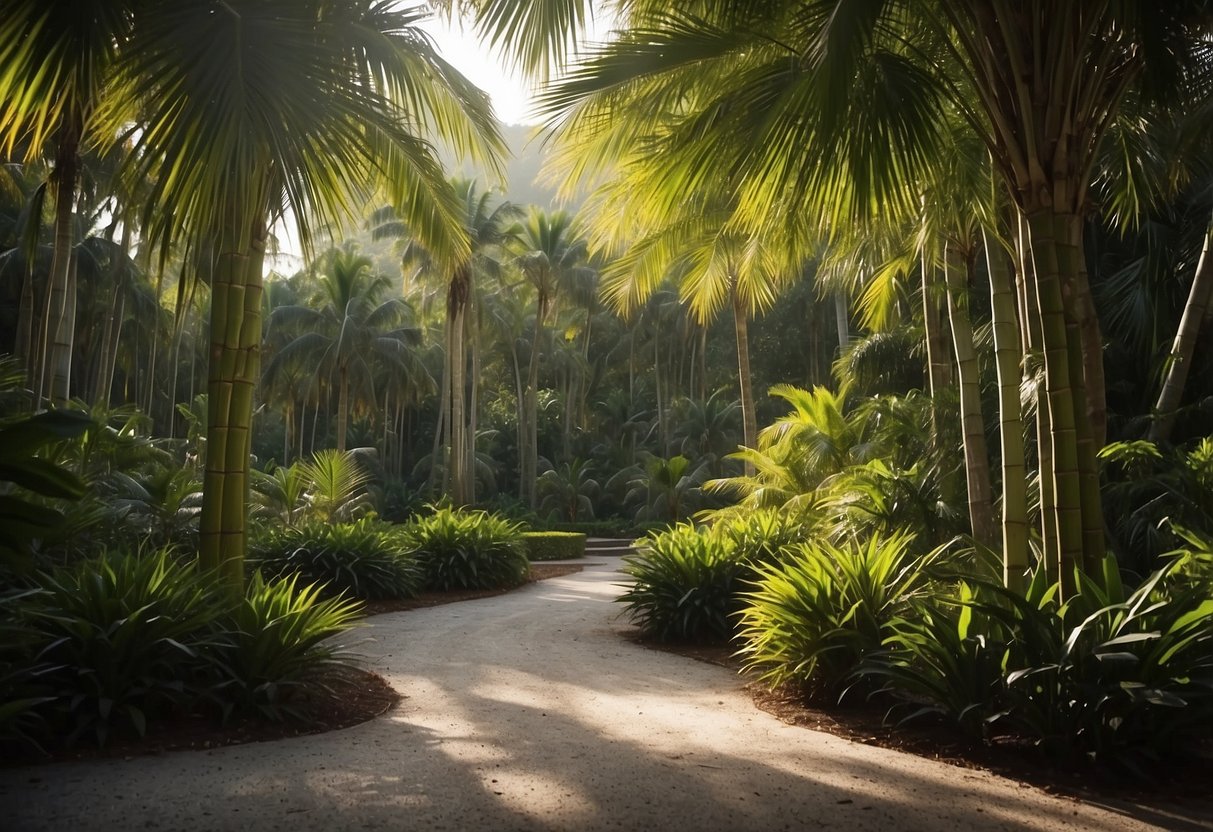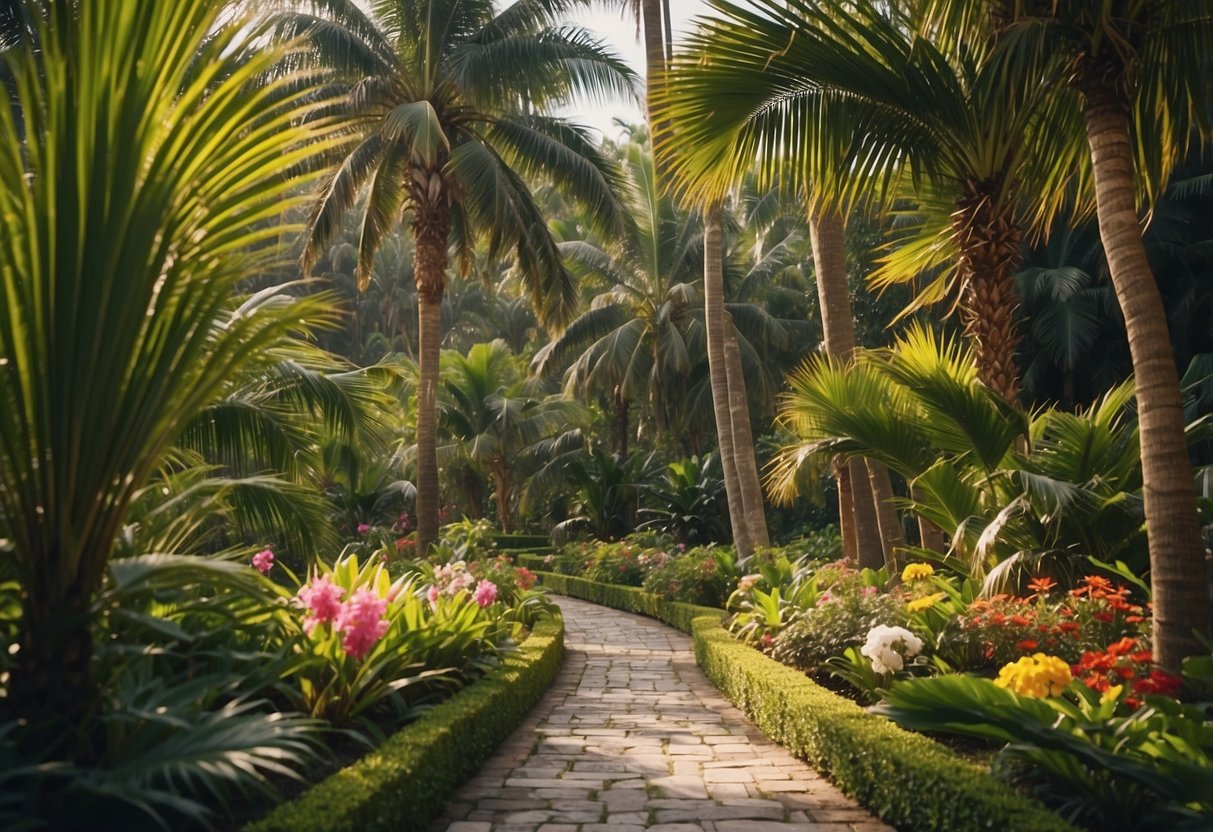Garden Ideas with Palms: Transform Your Outdoor Space
Palm trees can transform an ordinary garden into a tropical paradise. Their unique shapes and lush fronds bring a sense of relaxation and vacation right to your backyard. Whether you’re looking to create a poolside escape or enhance your front yard, palms offer versatility and beauty to any landscape.

Wondering how to incorporate palm trees into your garden for maximum effect? From towering giants to smaller ornamental varieties, there’s a palm tree perfect for every space and style. Dive into creative ideas and discover how these elegant plants can elevate your garden design.
1) Majestic Windmill Palm

The Windmill Palm is a charming addition to any garden. It can grow up to 40 feet tall in its natural habitat, although it is often smaller in cultivation.
This palm has fan-shaped leaves which create an elegant look. Its slow growth makes it easy to manage and perfect for small spaces.
For best results, plant it in well-draining soil. Avoid over-watering to prevent root rot. Use a slow-release, palm-specific fertilizer to keep it healthy. Regular but gentle pruning will help maintain its beauty.
You can learn more about it here.
2) Tranquil Bamboo Palm

The bamboo palm is a great addition to your garden. It stays on the smaller side, making it perfect for both indoor and outdoor spaces.
This palm thrives in lower light situations and prefers temperatures between 65°F and 80°F. Keep it away from cold drafts to ensure it stays healthy.
To care for your bamboo palm, water it regularly and provide well-draining soil. You can fertilize it monthly during spring and summer. If you want to learn more about bamboo palms, check out this detailed guide.
3) Elegant Sago Palm

The Sago Palm is a classic choice for adding beauty to your garden. Its dark green, feathery fronds give a tropical feel that stands out.
Pairing Sago Palms with blue fescue grass creates a stunning contrast. The blue foliage complements the palm’s rich green color.
To enhance the garden’s appeal, consider adding small backdrop plants like agave or crape myrtle. These plants enhance the overall look and make the Sago Palm the centerpiece of your garden.
4) Tropical Areca Palm

You can transform your garden into a tropical paradise with the Areca Palm. This palm has slender trunks and lush fronds that sway gently in the breeze. It’s perfect for creating a serene and inviting atmosphere.
Areca Palms thrive both in large planters and directly in the ground. You can use them to line walkways or create stunning hedges. Their versatility makes them a great choice for patios, balconies, and deck spaces.
By adding Areca Palms, you’ll bring a touch of tropical flair to your outdoor areas. Enjoy the lush greenery and relaxing vibes they provide.
5) Versatile Ponytail Palm

The ponytail palm is an excellent addition to your garden for its unique look and easy care. Its swollen base stores water, making it drought-tolerant.
To grow the ponytail palm outdoors, use well-draining soil and fertilize once a year in spring. You can find more tips on caring for this plant here.
This palm can also thrive indoors during colder months, giving you flexibility. Discover how to manage it in different environments by visiting this guide.
You’ll enjoy the distinct charm it brings to your garden space.
6) Beautiful Queen Palm

The Queen Palm is a delightful addition to any garden. Its long, arching fronds create a graceful and elegant look. These palms are ideal for both small and large spaces.
Queen Palms can grow up to 50 feet tall, making them a striking focal point. They also produce bright orange fruits, adding a splash of color to your garden.
To keep your Queen Palm healthy, water it regularly and make sure it’s planted in well-drained soil. This palm is quite forgiving of different soil types, which makes it a versatile choice for any garden.
7) Robust Needle Palm

Needle Palm is an excellent addition to your garden. It’s a tough plant that can tolerate both sun and shade.
This palm is perfect for low-maintenance gardening. It thrives in moist, well-drained soil and handles dry conditions well once established.
Best of all, the Needle Palm can survive temperatures as low as -15°F (-15°C). Learn more about its care here.
8) Classic Mediterranean Fan Palm

The Mediterranean Fan Palm is a beautiful addition to any garden. It’s known for its distinctive, fan-shaped leaves that give a lush, tropical vibe.
This palm thrives in various soil types, from clay to loam. It handles both slightly acidic and highly alkaline conditions. This makes it a versatile choice for different garden styles.
It’s hardy enough to withstand temperatures as low as 10 degrees Fahrenheit. For more ideas on how to incorporate this palm, check out these garden tips.
Plant it in raised planters or courtyards for an exotic touch.
9) Exotic Chinese Fan Palm

The Chinese Fan Palm stands out with its elegant, fan-shaped fronds. This palm can grow up to 10-12 feet, making it a stunning focal point in any garden.
It thrives in USDA zones 9-11, preferring full to partial sun and well-drained soil.
To grow this beauty, you’ll need to regularly water it and may want to consider occasional fertilization for optimal growth.
10) Azure Blue Hesper Palm

The Azure Blue Hesper Palm is a striking addition to any garden. It’s known for its beautiful blue-gray fronds that create a unique look. These fronds are fan-shaped and can grow up to 5 feet long.
You’ll enjoy the drought-tolerant nature of the Azure Blue Hesper Palm. It thrives in full sun and prefers well-draining alkaline soil. This palm can grow to 30-40 feet tall and 15-20 feet wide.
For more tips on growing the Blue Hesper Palm, check out this helpful guide.
Benefits of Incorporating Palms Into Your Garden

Adding palms to your garden can bring visual appeal, reduce maintenance time, and potentially increase your property’s value.
Enhanced Tropical Aesthetic
Palms can transform your garden into a lush, tropical escape. With their unique shapes and sizes, they help create a vibrant setting. The variety of colors, from green to purple, adds diversity.
Choose species like the Queen Palm with its slender trunk and lush canopy to line driveways or pool areas. These trees stand tall and elegant, providing a dramatic focal point. Planting different types of palms together can give your garden a layered look, making your space look more complex and interesting.
Low Maintenance Options
One big advantage of palms is how easy many of them are to maintain. Some species require occasional watering and pruning, but many are resilient and adaptable to various soil and climate conditions.
Chinese Windmill Palm is a good example. It’s cold-hardy and requires minimal care. You don’t need to spend much time on these trees once they’re established. They can thrive even in less-than-ideal environments, reducing your garden workload.
Increased Property Value
Incorporating palms can also increase your home’s value. These trees are often associated with luxury and a well-kept garden. Having palms can make your property more attractive to potential buyers.
A well-designed garden with mature palm trees can enhance curb appeal and make a strong first impression. The visual impact of a garden featuring palms can suggest that the entire property is equally well-maintained.
Benefits include quicker sales and possibly higher offers, as buyers may be willing to pay more for a home with beautiful landscaping.
Choosing the Right Palm Species

Choosing the right palm species requires careful consideration of climate, soil, water needs, and growth habits. Each palm species has specific requirements that can affect their health and appearance in your garden.
Climate Considerations
Climate plays a crucial role in selecting the right palm species. Some palms thrive in tropical climates, while others are more cold-hardy. For instance, the Caranday Palm can endure a range of temperatures. On the other hand, the Blue Palmetto is quite hardy and can withstand cooler weather.
Ensure you know your USDA hardiness zone before picking a palm. Palms suited for warm zones might struggle in colder areas. Conversely, cold-hardy palms may not flourish in hot, humid regions. Wind tolerance is another factor; some palms can handle strong winds, while others may not.
Soil and Water Requirements
The right soil and watering schedule are essential for healthy palms. Most palm species prefer well-drained soil types like sandy or loamy soils. Proper drainage is crucial to avoid root rot. Additionally, the soil’s pH level is vital, with most palms doing well in slightly acidic to neutral soils.
Different palms have varying water needs. For example, while the Copernicia alba loves moist soil, other species might require less frequent watering. It’s crucial to monitor the soil moisture and ensure a consistent watering schedule, especially during dry spells. Checking if the top 1-2 inches of soil are dry can help determine when it’s time to water.
Growth Habits and Sizes
Understanding the growth habits and sizes of different palm species helps in planning your garden layout. Some palms, like the Queen Palm, can grow tall and create significant shade. They are perfect for adding height and structure to your garden. For smaller spaces, consider species like the Blue Palmetto, which only grows up to 6 feet tall.
Consider the crown shape and leaf size as well. The Copernicia alba has large, fan-shaped fronds that provide a tropical look. In contrast, other palms might have smaller or more feathery foliage. Knowing the mature size and shape of the palm helps in placing it appropriately in your garden to avoid overcrowding.
Design Tips for a Palm-Focused Garden

When designing a garden centered around palms, you need to think about how to create focal points, pair palms with other plants, and use containers for added versatility. This ensures your garden is vibrant, dynamic, and adaptable.
Creating Focal Points
A key method to enhance your garden is by creating focal points with palms. Choose larger palms like Royal or Coconut palms to act as the centerpiece. Place them where your eyes naturally go, such as near the entrance or in the middle of a flower bed. For dramatic effect, consider grouping three palms together around one root zone. An odd number of specimens adds visual interest and promotes a balanced look.
Pairing Palms with Other Plants
For a rich, layered look, pair palms with plants that complement their tropical vibe. Try wood ferns, gingers, and elephant ears. These plants thrive in similar conditions and offer a variety of textures and colors. In a South Sea theme garden, palms like Princess, Red Feather, and Ruffled Fan can be mixed with these plants for a spectacular display. For a Caribbean theme, consider using Cuban Wax or Thatch palms paired with native flora.
Using Containers for Versatility
Containers add flexibility and style to your palm garden. They allow you to move palms around and experiment with different layouts. Small palms like Pygmy Date or Sago palms do well in containers. Use containers to highlight specific areas, such as patios or poolside spots. This also gives you the ability to protect your palms during harsh weather, ensuring they stay healthy and beautiful year-round.







